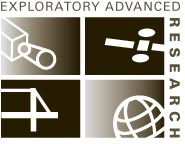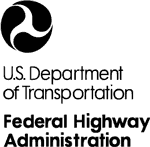U.S. Department of Transportation
Federal Highway Administration
1200 New Jersey Avenue, SE
Washington, DC 20590
202-366-4000
Federal Highway Administration Research and Technology
Coordinating, Developing, and Delivering Highway Transportation Innovations
| FACT SHEET |
| This fact sheet is an archived publication and may contain dated technical, contact, and link information |
| Publication Number: FHWA-HRT-12-029 Date: March 2012 |
Publication Number: FHWA-HRT-12-029 Date: March 2012 |
 Nano Material Modeling and Simulation: Developing a New Approach to Understanding Material Behaviors by Multiple Length/Time Scale Theories
Nano Material Modeling and Simulation: Developing a New Approach to Understanding Material Behaviors by Multiple Length/Time Scale Theories
PDF files can be viewed with the Acrobat® Reader®
|
Materials, structures, and sensors are the building blocks of transportation infrastructure. With so many potential applications, a fundamental understanding of the diverse physical properties is essential for effective ongoing monitoring and maintenance. "Nano Material and Simulation by New Multiple Length/Time Scale Theories and Algorithms" is a multiyear Federal Highway Administration (FHWA) Exploratory Advanced Research (EAR) Program study, in partnership with the George Washington University, aimed at developing a new approach to understanding the physical behavior of materials covering multiple length and timescales. |

Photo credit, © Shutterstock.com/ Jiri Vratislavsky |
The research is aimed at delivering new multiscale theories and computational codes to simulate material responses, and demonstrate applicability to specific problems in transportation infrastructure. The study builds on existing advances in multiscale modeling theories with an aim to construct an algorithm for numerical simulation to enable modeling of material behavior at multiple scales as efficiently as possible, which can be applied to specific problems in transportation infrastructure for safer, more efficient, and sustainable infrastructure. The theory and the algorithm will also be examined in the selected areas of highway material applications, including sensor and structural health monitoring, and material behavior under dynamic impact loading.
"Understanding the mechanical, thermal, and electromagnetic behaviors of various materials is essential in order to study their responses under different conditions and for various applications," explains Kunik Lee of FHWA. "At the root of this understanding is the study of behavior at the nanoscale level, however, current material and system responses are typically manifested and observed in their macroscopic behavior." This study aims to build on current understanding and existing theories to enable not only a better analysis of material responses under different environmental conditions and applied loading but also a better tool for design of new materials for enhanced durability, endurance, and improved behavior.
Integrating multiple timescales and material sizes are fundamental challenges for the study team to overcome in order to create a multiscale model. One of the specific issues in this study involves interfacing the concept of molecular dynamics, which involves simulating the physical movements of atoms and molecules, with continuum mechanics, which involves analyzing materials as a continuous mass rather than as individual particles. Once a general theoretical model has been successfully formulated, various conditions can begin to be added to the mix, including thermal and electromagnetic effects to better reflect the advantages of different material properties for highway structures and pavements. The construction of a flexible and compatible multiscale theory is something researchers consider key to successfully modeling material behavior.
The research team has already made significant contributions in the field of multiscale theory. Their literature review has shown that the proposed theories build on pioneering options in multiscale modeling methods. The team is minimizing research risks through small-scale simulations. A planned dissemination of research results through reputable refereed journals and conferences will also help to minimize risks and provide ongoing quality control.
"There are many potential benefits to be developed from this research. For example, it could lead to cost-effective repair of bridges and other structures, or the application of impact loading for safety of roadside and roadway appurtenances," says Kunik Lee. "Additionally, structural health monitoring applications could improve the safety of infrastructure, including bridges, roads, and asphalt; impact dynamics applications could enhance the crashworthiness and safety of the roadways and roadside structures; and sensor design applications could enhance the efficiency and cost-effectiveness of traffic control devices."
At the conclusion of this project, it is anticipated that FHWA will be able to utilize the new techniques and tools to investigate various material failures in roadside safety equipment, critical structural elements, or for structural health monitoring. In the long term, it is expected that the tools developed under this research will assist transportation engineers and managers to gain a better and more accurate understanding of material behavior in various segments of the transportation infrastructure—enabling improved material design and ultimately a more efficient, cost-effective, and sustainable transportation infrastructure. It is also anticipated that the findings of this study will be useful to various research or testing groups at FHWA, other USDOT agencies, academic institutions, State departments of transportation, and industry.
For more information on this EAR Program project, contact Kunik Lee, Ph.D., FHWA Office of Safety Research and Development, at 202-493-3491 (email: kunik.lee@dot.gov).
What Is the Exploratory Advanced Research Program?FHWA’s Exploratory Advanced Research (EAR) Program focuses on long-term, high-risk research with a high payoff potential. The program addresses underlying gaps faced by applied highway research programs, anticipates emerging issues with national implications, and reflects broad transportation industry goals and objectives. To learn more about the EAR Program, visit the Exploratory Advanced Research Web site at www.fhwa.dot.gov/advancedresearch. The site features information on research solicitations, updates on ongoing research, links to published materials, summaries of past EAR Program events, and details on upcoming events. For additional information, contact David Kuehn at FHWA, 202-493-3414 (email: david.kuehn@dot.gov), or Terry Halkyard at FHWA, 202-493-3467 (email: terry.halkyard@dot.gov). |

